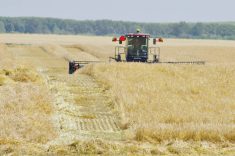The National Research Council is ruling out research into genetically engineered wheat as it puts the final touches to a plan to support wheat research across Canada to double yields and improve drought tolerance and disease resistance.
Wheat has become the poor cousin to corn, soybeans, canola, pulses and other crops that have attracted a lot of private-sector investment. Details and the cost of the research program will be released later, says NRC spokesman Charles Drouin.
The goal is to reduce the cost of planting and growing wheat crops by reducing the amount of fertilizer they require. Higher yields will allow farmers to increase exports, he added.
Read Also

Manitoba sclerotinia picture mixed for 2025
Variations in weather and crop development in this year’s Manitoba canola fields make blanket sclerotinia outlooks hard to pin down
The main partners in the program will be Agriculture Canada and the University of Saskatchewan Crop Development Centre. The NRC will join an international effort to sequence the wheat genome to understand what traits need to be tweaked.
The NRC program has drawn applause from Grain Growers of Canada and the Canadian Wheat Board.
“We are really, really pleased to hear that cereal and especially wheat will be a research priority. Research on wheat has slipped drastically over the last few years and wheat yields have slipped behind other crops. Wheat has become less appealing for farmers to grow compared to other crops,” said Richard Phillips, executive director of Grain Growers of Canada in a release.
Maureen Fitzhenry, spokeswoman for the Canadian Wheat Board, told iPolitics the board, which markets Prairie wheat and barley, “has held preliminary discussions with the NRC, which could include the CWB serving on a research advisory board.”
The board supports “strong proponents for increased investment and research especially in the public sector,” she notes. The priorities should be increased yields, high quality, hardiness to withstand climate changes and better resistance to diseases which both reduce yields and create toxins such as fusarium that are a threat to human health.
There are a number of facilities across the West where research could be conducted, she said.
Drouin says the NRC wheat research initiative is part of the council’s efforts to focus on “national-scale programs that have a critical mass of expertise and investment to deliver high impacts for Canada.” The council thinks “productivity of Canadian wheat has not seen the rates of increase as some other countries, due to a number of challenges including a relatively short growing season and a dry climate in much of the wheat-growing region.”
Drouin says the NRC program will “complement the existing Canadian breeding pipeline to help improve the competitiveness of future Canadian wheat varieties. Canadian wheat needs improvement to achieve sustainable profitability for farmers. In comparison with other commodity crops that have seen significantly higher rate of productivity improvement over the last 10 years, on average wheat does not produce enough return to make it a preferred crop choice for Canadian farmers.”
NRC wants to work with farm groups, plant breeders and organizations involved in the registration and marketing of Canadian wheat to ensure that varieties developed are consistent with market needs and priorities.
Some work has been done in the United States and Australia on developing a genetically engineered wheat to increase yields and improve tolerance to drought and excessive moisture, but no variety has been submitted for registration. The CWB has said GE wheat should not be introduced until importing countries are willing to accept it.


















